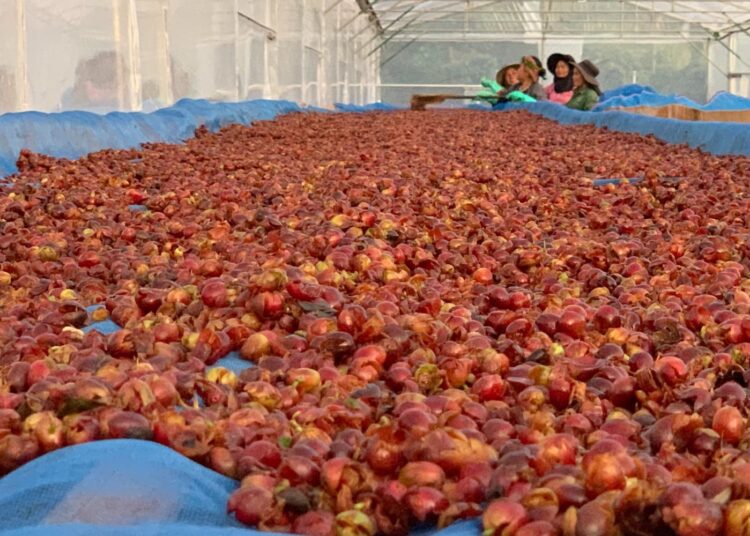ofi’s innovation teams are focused on re-purposing by-products to offer consumers new nutritious and sustainable ingredients. It explains how it creates differentiated coffees through alternative processing methods.
ofi’s coffee business, part of olam food ingredients and formerly known as Olam Coffee, is developing ways of upcycling the pulp and skin of the coffee cherry to create novel cascara products. Currently, the pulp and skin of coffee cherry is simply stripped from the coffee bean and often discarded, used as fertiliser, or sold for cattle feed.
At the end of a two-year project, ofi has developed cascara ingredients that the company believes has a wide range of uses in beverage, bakery, and confectionery applications. “We believe this new product has a unique and interesting flavour profile and it has potential health benefits thanks to its levels of antioxidants,” says Vivek Verma, Managing Director for Coffee at ofi.
Cascara trials have been carried out on ofi’s certified, single origin Arabica estates in Zambia and Laos, which Verma says allow end-to-end quality control with full traceability. At ofi’s new innovation centre in Chicago, United States, the company is developing new cascara products derived from various processing conditions, in partnership with external laboratories and customers to meet their specifications.
The ofi team has tried various methods of husk and pulped cascara to see which produces the best flavour. Verma says these two processing methods produce quite different flavour profiles. Using the pulped method during wet processing, the fruit pulp is collected and dried slowly on raised beds in a controlled environment.
Verma says it is a pity that cascara has not been used already for wider human consumption, though the inspiration for the project came from seeing it used in rural communities on a much smaller scale. He also points out that utilising the fruit contributes to more eco-friendly production.
“Cascara is a by-product [of coffee cherries] but by upcycling, we’re diverting it from the waste stream and reducing the environmental burden from methane emissions,” Verma says.
Verma points out that the majority of the coffee cherry goes to landfill and is left to decompose in heaps. As the microbes break the pulp down, it releases a range of greenhouse gases including methane in the atmosphere.
The added benefit of this upcycled by- product, however, is providing an additional income stream for coffee farmers.
Converting cascara into an ingredient for human consumption was a major focus of ofi’s project. It had to make sure that, first and foremost, there was no biological contamination so that the coffee fruit was safe to eat. The second challenge was to make sure it could process the cascara at scale, and with consistency.
Verma is excited about the product’s potential. ofi is working with a range of businesses in the coffee industry to see if production can be scaled up, through involving more companies.
But cascara is not the only ofi innovation that has been bearing fruit of late. The company is experimenting with extended fermentation techniques during processing to elevate the cup quality of washed Arabicas.
“There are three factors that influence the flavour profile of coffee,” says Verma. “First the variety, second the terroir and conditions, and thirdly, processing. It is through processing that we can have the most influence, so we have focused on fermentation techniques as a driver of cup quality.”
In dry processing, full cherries are dried prior to de-pulping and the husk is removed. In wet processing, cherries are pulped to separate the beans, with the remaining mucilage allowed to ferment before being washed off and the beans dried.
Similar to the use of yeasts and cultures in many fermented foods like wine, beer or yoghurts, ofi has experimented with various starter cultures in its processing facilities across a number of coffee origins to understand the effect in generating favourable metabolites.
“In many of the coffees we’ve trialled, we have seen quality increases of as much as three to four points on the Specialty Coffee Association [grading] scale – from a cup score of 81 to 85-plus. This not only adds value for our customers but helps farmers maximise earnings from their coffee too,” Verma says.
The key here, Verma stipulates, is training farmers on the right techniques so they can upgrade the quality of their beans to improve their livelihood without increasing production costs. As cup scores go up, so can their profits.
These two projects are part of a wider innovation focus at ofi.
“Both innovation and sustainability are key to making our purpose real, ‘to be the change for good food and a healthy future’,” continues Verma. “Having our own processing capabilities, and close relationships with farmers mean we’re always looking at how to add value from crop to cup.” GCR
For more information, visit ofi.com
This article was first published in the July/August 2022 edition of Global Coffee Report. Read more HERE.





